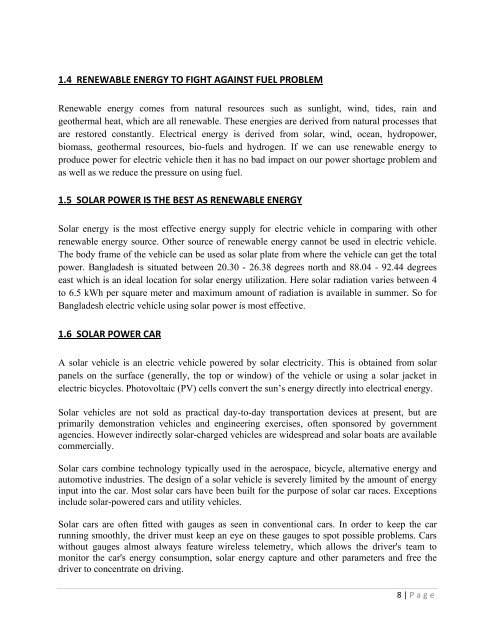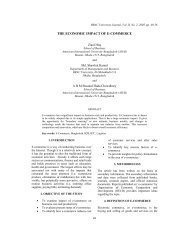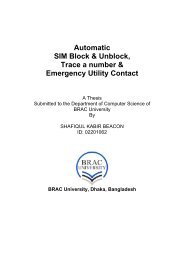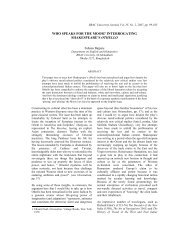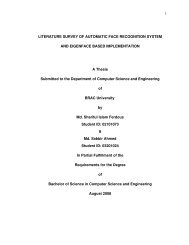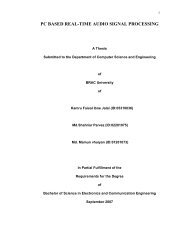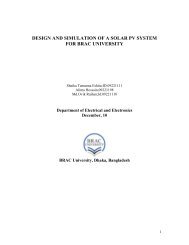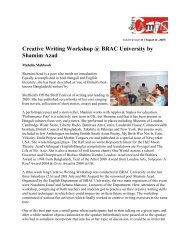design a solar powered clean car - of DSpace - BRAC University
design a solar powered clean car - of DSpace - BRAC University
design a solar powered clean car - of DSpace - BRAC University
You also want an ePaper? Increase the reach of your titles
YUMPU automatically turns print PDFs into web optimized ePapers that Google loves.
1.4 RENEWABLE ENERGY TO FIGHT AGAINST FUEL PROBLEM<br />
Renewable energy comes from natural resources such as sunlight, wind, tides, rain and<br />
geothermal heat, which are all renewable. These energies are derived from natural processes that<br />
are restored constantly. Electrical energy is derived from <strong>solar</strong>, wind, ocean, hydropower,<br />
biomass, geothermal resources, bio-fuels and hydrogen. If we can use renewable energy to<br />
produce power for electric vehicle then it has no bad impact on our power shortage problem and<br />
as well as we reduce the pressure on using fuel.<br />
1.5 SOLAR POWER IS THE BEST AS RENEWABLE ENERGY<br />
Solar energy is the most effective energy supply for electric vehicle in comparing with other<br />
renewable energy source. Other source <strong>of</strong> renewable energy cannot be used in electric vehicle.<br />
The body frame <strong>of</strong> the vehicle can be used as <strong>solar</strong> plate from where the vehicle can get the total<br />
power. Bangladesh is situated between 20.30 - 26.38 degrees north and 88.04 - 92.44 degrees<br />
east which is an ideal location for <strong>solar</strong> energy utilization. Here <strong>solar</strong> radiation varies between 4<br />
to 6.5 kWh per square meter and maximum amount <strong>of</strong> radiation is available in summer. So for<br />
Bangladesh electric vehicle using <strong>solar</strong> power is most effective.<br />
1.6 SOLAR POWER CAR<br />
A <strong>solar</strong> vehicle is an electric vehicle <strong>powered</strong> by <strong>solar</strong> electricity. This is obtained from <strong>solar</strong><br />
panels on the surface (generally, the top or window) <strong>of</strong> the vehicle or using a <strong>solar</strong> jacket in<br />
electric bicycles. Photovoltaic (PV) cells convert the sun’s energy directly into electrical energy.<br />
Solar vehicles are not sold as practical day-to-day transportation devices at present, but are<br />
primarily demonstration vehicles and engineering exercises, <strong>of</strong>ten sponsored by government<br />
agencies. However indirectly <strong>solar</strong>-charged vehicles are widespread and <strong>solar</strong> boats are available<br />
commercially.<br />
Solar <strong>car</strong>s combine technology typically used in the aerospace, bicycle, alternative energy and<br />
automotive industries. The <strong>design</strong> <strong>of</strong> a <strong>solar</strong> vehicle is severely limited by the amount <strong>of</strong> energy<br />
input into the <strong>car</strong>. Most <strong>solar</strong> <strong>car</strong>s have been built for the purpose <strong>of</strong> <strong>solar</strong> <strong>car</strong> races. Exceptions<br />
include <strong>solar</strong>-<strong>powered</strong> <strong>car</strong>s and utility vehicles.<br />
Solar <strong>car</strong>s are <strong>of</strong>ten fitted with gauges as seen in conventional <strong>car</strong>s. In order to keep the <strong>car</strong><br />
running smoothly, the driver must keep an eye on these gauges to spot possible problems. Cars<br />
without gauges almost always feature wireless telemetry, which allows the driver's team to<br />
monitor the <strong>car</strong>'s energy consumption, <strong>solar</strong> energy capture and other parameters and free the<br />
driver to concentrate on driving.<br />
8 | P age


